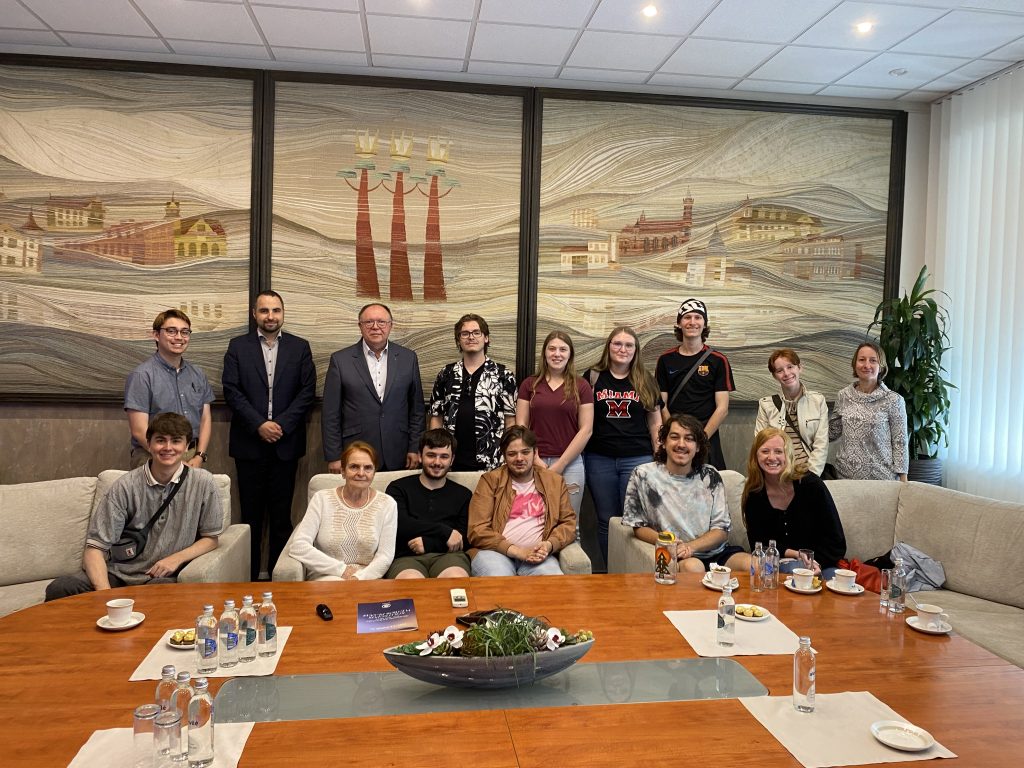By Ashley Morris
People travel the world to experience differences. They compare everything from the language, food, and customs to famous buildings, art, and history, to what they have at home. For me, these comparisons started even before I landed for my summer workshop study in Vilnius, the capital of Lithuania. What struck me the most was not the difference in mannerisms or fashion, but the European effort toward sustainability. It took a couple days of ordering food and receiving wooden utensils, paper straws and cups, and glass water and soda bottles to realize that these measures were not limited to individual restaurants or cafes. Even more so, my layovers in Reykjavik, Iceland and Copenhagen, Denmark demonstrated how plastic and recycling efforts were not just limited to Lithuania, but were in place throughout the entire European Union.
As an American who holds on to plastic bags and utensils in the hopes of reusing them, this was an incredible realization. Plastic bottles, a sight on every highway or beach in the United States, were obsolete. I had never been given a wooden spoon in the US, but it was the only take-away option available in Lithuania and Iceland. Not only were my straws paper, but so were the cups (and although they eventually got soggy, they never leaked). Everything was delivered in a paper bag, and if you didn’t bring your reusable bag to the grocery store, you had to pay for a plastic one. Different parts of the US have varying levels of these protocols, but nowhere has all of them, and not to this extent. It’s possible that the EU is making this much headway with decreasing plastic consumption because of low plastic recycling rates. In the EU, only 14% of plastics are actually recycled. While this number seems low, it is well above the global average of 9% and almost incomparable to the US’ 4% (Pratty 2022). If anyone needs to do something about it, it is the US.
I was very interested in how these measures came to be since similar legislation in the US is at the local level. I was elated to find that they were headlined by the EU itself. Since starting its programs in 2018, the EU has since banned the sale of the 10 most common single-use plastics found on Europe’s beaches, for which sustainable alternatives are readily available and affordable, including cotton-bud sticks, cutlery, plates, straws, balloon sticks, and coffee stirrers. All oxo-degradable plastics and food and beverage containers made from expanded polystyrene (Styrofoam) are also included in the ban. For items with no alternatives, member states must submit an outline of their plans to reduce consumption of these products to the European Commission and to its population. These might include “instituting national reduction targets, providing reusable alternatives at the point of sale to consumers, or charging money for single-use plastic products” (Gelsey 2021). The EU has set a deadline of 2026 to achieve a significant reduction in these no-alternative single-use plastics, with the end goal being a complete stop to their consumption.
While I was excited about all of these efforts, I was also upset that the entire European Union was making progress at combating climate change, and the US is still stuck on whether it is real or not. Even worse, parts of the US have actually banned the banning of plastic. These preemptive laws are spearheaded by plastic-industry lobbyists, who are looking to secure their industry’s future profits at the cost of the global climate crisis. In total, 17 states have some sort of restriction on any local government wanting to ban single-use plastics while 10 of them have outright bans. Overall, one-third of the United States is unable to make their own legislation regarding the future of our environment because of the plastic-producing companies, not what the people actually believe should be done.
The idea to focus on this subject for my workshop op-ed writing assignment was spurred by our visit with the Deputy Mayor of Druskininkai, Linas Urmanavičius. Druskininkai is a resort and spa town in Southern Lithuania whose mineral water has been used for centuries to treat various ailments. Doctors even write a prescription for a stay there. Over the last 10 years, the city’s substantial efforts to increase tourism have been widely successful, with Druskininkai welcoming 350,000 tourists who stay for 1.2 million nights. In addition to the relaxation and rejuvenation of the spas, guests also enjoy a 30,000 square meter Aqua Park, shopping and dining, boating on a lake, and a 20 acre indoor Snow Arena, with skiing and snowboarding.


Mr. Urmanavičius was proud to tell us all about his city and the sustainable measures they have taken and been mandated to take. He explained that with some of the funding they receive from the EU to develop their city, they are required to hit certain environmental benchmarks and achieve certain numbers. These additional requirements are a way for the EU to ensure that their measures to combat climate change are actually being implemented. I believe that if the US would adopt this policy, we would see a lot of change.
To me, the most significant and interesting program in Druskininkai is their fleet of electric buses. When we met with Mr. Urmanavičius, there were about 9 buses in use, with another 25 set to be delivered in the next year or so. Mr. Urmanavičius was very proud of this, and he had good reason to be. Druskininkai’s electric bus fleet surprised me the most because American cities are years away from having even a couple of electric buses. Not only that, but it is a decision made by the city and not one of required of them. It is pushed by their own desire to do their part to combat climate change.
There are many hurdles to having a similar fleet in the US. My research showed that some key barriers include a lack of charging infrastructure and difficulties in making changes to “rigid procurement structures.” Monetary barriers also exist, like the lack of long-term financing and institutional funding. Expense is often the first reason given for not switching public transportation to electricity. But Mr. Urmanavičius told us that by their calculations, the program would pay for itself in just seven years, a short amount of time for any major investment like this. Similar to the bans on banning plastic, electric vehicles must go against the oil industry giants, whose money influences public policy.
I feel as if we are told by our government–both at the local and national level–that making these changes to be more sustainable is too expensive and difficult to implement fully. But my time in the EU has revealed that is not the full story. Druskininkai was willing to deal with the expense of their electric vehicles knowing that their costs would be negated in seven years. Lithuania and other EU countries with significantly lower GDPs than the United States have been able to switch almost entirely to plastic alternatives. For context, Lithuania’s GDP is 55.89 billion USD (US dollars). The United States’ is 20.94 trillion USD. The US has the ability to make these changes and deal with the immediate economic consequences, it just chooses not to. Short-term profits are more important than long-term environmental health.
Another excuse often given is the lack of infrastructure to make these changes, and the loss of plastic manufacturing or fossil fuel related jobs. While this is true in some communities, if sustainable changes are not made, that infrastructure will never be built. There is no way to lower the costs of sustainability if it is never started in the first place. I also completely understand that some opponents to these changes have made their livelihoods on the very things the US would be walking away from. By using sustainable alternatives, coal miners and factory workers are likely to lose their jobs eventually. The US can learn from what the EU has done to solve similar issues. Perhaps one solution is to teach them the skills necessary to work with plastic-alternative manufacturing or at reusable energy plants. There are solutions to these problems. Unfortunately, US governments do not seem to agree.
To say it’s a shame is an understatement. One study found that 81% of Americans are in favor of legislation reducing single-use plastics at the local, state, and national level (Valliant 2022). The barriers to sustainability in the US are not in the lack of public support to do so, but the power of lobbyists and the threat of short-term economic loss. Before my study abroad, I knew things needed to change, and that there were not strong reasons for the US not to. But after seeing how the EU has implemented policies quickly and successfully, I know there is no excuse for America not to do the same.
Ashley Morris is a senior majoring in Anthropology and Global and Intercultural Studies with a minor in Russian.
Sources
Commission, European. “5 Ways the EU Is Working to Fight Plastic Pollution.” Medium, Medium, 28 Oct. 2019, https://europeancommission.medium.com/5-ways-the-eu-is working-to-fight-plastic-pollution-e6d26500d47b.
Earthday.org. “A Third of the US Has Laws Preventing Plastic Bans.” Earth Day, 6 July 2021, https://www.earthday.org/a-third-of-the-us-has-laws-preventing-plastic-bans/.
Gelsey, Jenny. “European Union: Ban on Single-Use Plastics Takes Effect.” The Library of Congress, 2021,
https://www.loc.gov/item/global-legal-monitor/2021-07-18/european-union-ban-on single-use-plastics-takes-effect/.
“New Brand and Visual Identity of Druskininkai.” Visit Druskininkai,
https://druskininkai.lt/en/news/druskininkai-present-their-new-city-brand-and-visual identity-discover-your-new-me/.
Pratty, Freya. “In Numbers: Europe’s Plastic Problem.” Sifted, 24 Mar. 2022, https://sifted.eu/articles/sustain-chart-plastic/.
Sclar, Ryan, et al. “Barriers to Adopting Electric Buses.” World Resources Institute, 5 Sept. 2020, https://www.wri.org/research/barriers-adopting-electric-buses.
“Single-Use Plastics.” Environment, https://environment.ec.europa.eu/topics/plastics/single use-plastics_en.
Staff, Editorial. “TEMSA Wins a 9-Units e-Bus Tender in Lithuania.” Sustainable Bus, 5 Jan. 2022, https://www.sustainable-bus.com/electric-bus/temsa-wins-a-9-units-e-bus tender-in-lithuania/.
Valliant, Melissa, Cranor, Dustin, et al. “8 In 10 American Voters Support National Action to Reduce Single-Use Plastic.” Oceana USA, 11 Feb. 2022,
https://usa.oceana.org/press-releases/8-in-10-american-voters
support-national-action-to-reduce-single-use-plastic/.

